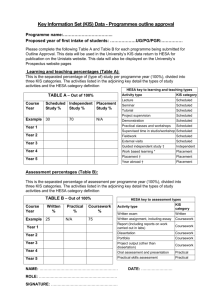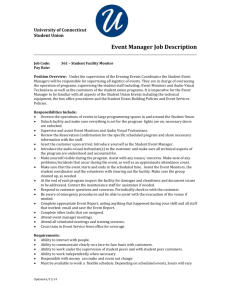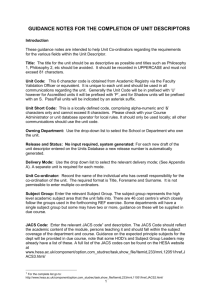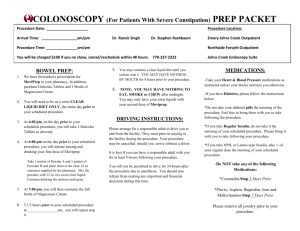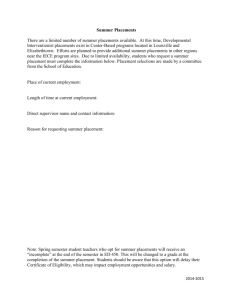Module Descriptor Guidance
advertisement
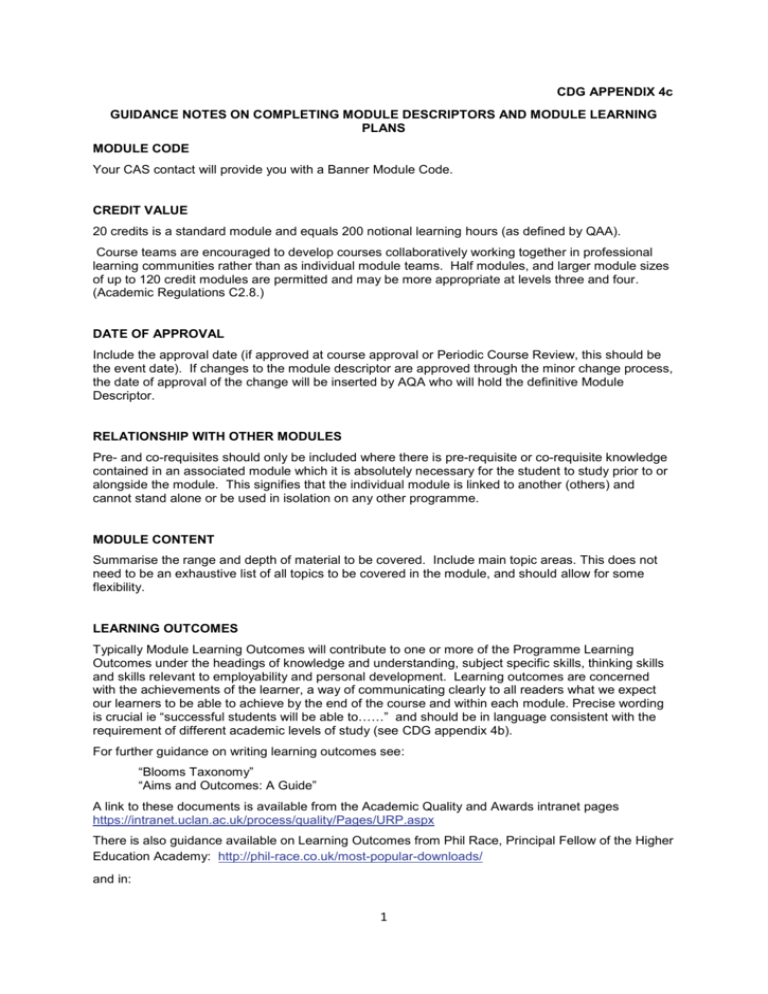
CDG APPENDIX 4c GUIDANCE NOTES ON COMPLETING MODULE DESCRIPTORS AND MODULE LEARNING PLANS MODULE CODE Your CAS contact will provide you with a Banner Module Code. CREDIT VALUE 20 credits is a standard module and equals 200 notional learning hours (as defined by QAA). Course teams are encouraged to develop courses collaboratively working together in professional learning communities rather than as individual module teams. Half modules, and larger module sizes of up to 120 credit modules are permitted and may be more appropriate at levels three and four. (Academic Regulations C2.8.) DATE OF APPROVAL Include the approval date (if approved at course approval or Periodic Course Review, this should be the event date). If changes to the module descriptor are approved through the minor change process, the date of approval of the change will be inserted by AQA who will hold the definitive Module Descriptor. RELATIONSHIP WITH OTHER MODULES Pre- and co-requisites should only be included where there is pre-requisite or co-requisite knowledge contained in an associated module which it is absolutely necessary for the student to study prior to or alongside the module. This signifies that the individual module is linked to another (others) and cannot stand alone or be used in isolation on any other programme. MODULE CONTENT Summarise the range and depth of material to be covered. Include main topic areas. This does not need to be an exhaustive list of all topics to be covered in the module, and should allow for some flexibility. LEARNING OUTCOMES Typically Module Learning Outcomes will contribute to one or more of the Programme Learning Outcomes under the headings of knowledge and understanding, subject specific skills, thinking skills and skills relevant to employability and personal development. Learning outcomes are concerned with the achievements of the learner, a way of communicating clearly to all readers what we expect our learners to be able to achieve by the end of the course and within each module. Precise wording is crucial ie “successful students will be able to……” and should be in language consistent with the requirement of different academic levels of study (see CDG appendix 4b). For further guidance on writing learning outcomes see: “Blooms Taxonomy” “Aims and Outcomes: A Guide” A link to these documents is available from the Academic Quality and Awards intranet pages https://intranet.uclan.ac.uk/process/quality/Pages/URP.aspx There is also guidance available on Learning Outcomes from Phil Race, Principal Fellow of the Higher Education Academy: http://phil-race.co.uk/most-popular-downloads/ and in: 1 First Words on Teaching and Learning, by David Baume, previously of Oxford Centre for Staff and Learning Development (e-book free to download): http://shop.brookes.ac.uk/browse/extra_info.asp?compid=1&modid=1&deptid=47&catid=227&prodid= 948 Learning outcomes should be restricted to a maximum of 5 learning outcomes for a 20 credit module. Please focus learning outcomes on learning processes, rather than content., This gives course teams flexibility to update content and make enhancements arising from the course team’s reflections and reviews and feedback from stakeholders including students, professional bodies and employers.. ASSESSMENT METHODS Only summative assessment should be included. Module teams should ensure they work with the course team to design an appropriate range of assessments at each level (see the module assessment workload guidance). Time spent on formative assessment and the learning within the broader assessment for learning strategy should be included within the calculation of learning and teaching activities. The maximum number of assessment components is normally 2 per 20 credit module. All modules should embed assessment for learning within the activities and include as part of the teaching and learning strategy formative assessment tasks that enable the provision of timely, actionable feedback for improvement. This section should also include any assessment which a student must pass (eg a skills test) but does not attract a mark (eg Satisfactory/Unsatisfactory). The method of assessment for the module must test all the learning outcomes. Students must demonstrate successful achievement of these learning outcomes to pass the module. Category of Assessment The table below gives examples shows how each of these methods should be categorised for the purpose of the KIS (written exam; practical assessment; coursework). Select which assessment category is most appropriate for each assessment. Where elements of assessment fall into more than one category of assessment, these must be split accordingly, eg if students must complete a project and present the outcomes and the grade reflects both the written project and the presentation, the assessment must be split across practical (presentation) and coursework (project) to reflect the weightings given to these 2 elements. Activity type KIS assessment category Written exam Written exam A question or set of questions relating to a particular area of study: Written exams usually occur at the end of a period of learning, and assess whether students have achieved the intended learning outcomes. They may be ‘seen’, where the student is aware in advance of the question(s) they are expected to answer, or ‘unseen’ where the questions are only revealed ‘on the day’. In an open-book exam a student is allowed to use a selection of reference materials during the assessment. The questions asked as part of a written exam may be essay, short answer, problem or multiple choice. Written exams usually (but not always) take place under timed conditions. (Exams that are taken home should be counted as coursework as the associated conventions of examinations such as timed constraints and authenticity of students’ work do not apply.) Written assignment, including essay Coursework An exercise completed in writing. 2 Written exercises that typically have deadlines attached but which are not carried out under timed conditions. A well-known example is the essay, where students are required to write about a particular topic or answer a question in depth. Other examples include written briefings on particular topics. Report Coursework A description, summary or other account of an experience or activity. There are many different kinds of report- often students are required to produce a report after participating in a practical activity such as fieldwork, laboratory work, work experience or placement. Reports typically have a prescribed format. Dissertation Coursework An extended piece of written work, often the write-up of a final-year project. A dissertation is a substantial piece of writing deriving from research that a student has undertaken. Dissertations are the result of a student’s independent work, carried out under the guidance of a supervisor. Different subject areas may follow different conventions in relation to the production of dissertations. (Note that other outputs from projects are listed separately.) Portfolio Coursework A collection of work that relates to a given topic or theme, which has been produced over a period of time. Typically, a portfolio contains a number of pieces of work, usually connected by a topic or theme. Students are usually required to organise the collection of examples and the portfolio often includes some reflective accounts (diaries/logs). Examples include, in education that students may collect in portfolio essays around particular teaching methods, lesson plans, teaching materials that they have developed and a report about the teaching experience itself. For the purposes of the KIS, examples also include the creative arts portfolio which may contain a strong practical element. Project output (other than dissertation) Coursework Output from project work, often of a practical nature, other than a dissertation or written report. Students are assessed on the output of a period of project work (other than in the form of a dissertation or written report). Examples are diverse and include a piece of artwork, a new product or poster. Oral assessment and presentation A conversation or oral presentation on a given topic, including an individual contribution to a seminar. Practical assessment Examples of oral assessments and presentations might include conversations, discussions, debates, presentations and individual contributions to seminars. This category would also include the viva voce exam which is typically used by institutions in specific circumstances such as clarifying assessment decisions reached by other means. Practical skills assessment Assessment of a student’s practical skills or competence. Practical skills assessment focuses on whether, and/or how well, a student performs a specific practical skills or technique (or competency). Examples include clinical skills, laboratory techniques, identification of or commentary on artwork, surveying skills, language translation or listening comprehension, music, dance or drama performances and so on. 3 Practical assessment Set exercises Varies Questions or tasks designed to assess the application of knowledge, analytical, problem-solving or evaluative skills. Examples might include data interpretation and data analysis exercises and problem-based or problem-solving exercises. The categorisation of set exercises will depend on the nature of the exercise being set. Typically, set exercises will not be conducted under exam conditions and will therefore normally be coursework. Where the set exercise is performed under exam conditions and does not involve the use of practical skills it should be treated as a written exam. Otherwise it should be a practical exam. Peer assessment is not categorised as a separate assessment method, and should be included within the assessment type that peers are assessing, eg if peer assessment is of a presentation, then this should be treated as a practical exam (see table). Further information on the categories of learning and teaching methods can be found at: https://www.hesa.ac.uk/index.php?option=com_studrec&task=show_file&mnl=15061&href=Calcula tions_methods.html MODULE PASS REQUIREMENTS This section should indicate the specific pass requirements for the module, which will normally be an aggregated mark. Where professional or accrediting bodies require non-aggregation, please include the relevant guidance so that the approval process may ensure that the wording approved meets their requirements. FURTHER GUIDANCE For further guidance on designing modules, see links on AQA intranet https://intranet.uclan.ac.uk/process/quality/Pages/cdg.aspx in particular “First Words – a Guide to Teaching and Learning” by David Baume, Oxford Brookes University. APPENDIX TO MODULE DESCRIPTOR MODULE TEAM Name of person(s) responsible for the delivery of the module. If more than one person is delivering, identify in bold the Module Leader (person with overall responsibility for the module). Where modules are franchised to partner institutions, this will remain the UCLan Module Leader unless the module is validated for delivery only at a partner institution. LOCATION OF STUDY 4 If an individual module is delivered in different locations (UCLan campuses; Partner institution; by distance learning) there may be differences in how it is delivered. Where this is the case, please indicate which location of study the appendix refers to. MODULE DELIVERY Please indicate when you are intending to deliver the module, so that it can be set up appropriately on Banner, and used for timetabling purposes. This might be across a traditional semester, over a full academic year, or in particular blocks of teaching weeks etc. Please indicate as appropriate. MODULE LEARNING PLAN (MLP) All modules should include details of the average learning time based upon 200 hours per 20 credit module. Where there are additional hours over and above the 200 per 20 credit module, eg where students attend clinical placements, these will not be associated with credit, but should still be recorded. (For KIS purposes, the additional hours associated will be added to the numerator and denominator of the calculation.) Time spent on formative assessment should be included within the calculation of teaching and learning methods. Time spent on summative assessment (eg examination should NOT be included. “Office hours” where staff are available to students, but where this time is not individually scheduled cannot be included in scheduled contact hours. The table below indicates how learning and teaching should be categorised for the purpose of the KIS. Further information on the categories of learning and teaching methods can be found at: https://www.hesa.ac.uk/index.php?option=com_studrec&Itemid=232&mnl=15061 Activity type KIS category Lecture Scheduled learning and teaching Seminar Scheduled learning and teaching Tutorial Scheduled learning and teaching Project supervision Scheduled learning and teaching Demonstration Scheduled learning and teaching Practical classes and workshops Scheduled learning and teaching Supervised time in studio/workshop Scheduled learning and teaching Fieldwork Scheduled learning and teaching External visits Scheduled learning and teaching Guided independent study Independent study Work based learning Placement Placement Placement Year abroad Placement NB Time spent on formative assessment should be included within the calculation of learning and teaching methods. The categories in which formative assessments are included within the learning and teaching activities will depend on their exact nature. For example, a class test may contribute to both scheduled learning and teaching activities (for the time spent taking the test) and guided independent study (for the time spent revising/preparing for the test). 5 LEARNING, TEACHING AND ASSESSMENT STRATEGY Rationale for the way in which the learning, teaching and assessment will deliver the module aims. What is the student expected to do during the module? How will you deliver the module? Will the module be delivered on-campus, by blended learning, e-learning, distance learning etc? Provide examples of how skills and attributes will be developed and how learning and teaching (including formative assessment) are supported and informed by research. KIS categories are as follows (see below for further guidance): Scheduled learning and teaching Placement (includes work-based learning/year abroad) Guided independent study SCHEDULED TEACHING AND LEARNING ACTIVITY For the purposes of the KIS, this includes lectures, tutorials, seminars, project supervision, demonstrations, practical classes and workshops, supervised time in studio/workshop, fieldwork, external visits. The following is extracted from the guidance provided by HESA: Lecture - a presentation or talk on a particular topic. The term 'lecture' covers everything from the traditional model, where a single member of the institution's staff or an affiliate (ie a lecturer researcher, technician, member of support staff or Graduate Teaching Assistant of the institution or a visiting or expert specialist) introduces ideas or delivers facts to a group of students, to approaches that might be much more interactive, involve a variety of contributors, make use of a range of media and technologies, and take place virtually as well as in person. Lectures are assumed, in general, to involve larger groups of students than do seminars and tutorials but size will vary depending upon the nature of what is being taught, the size of the overall student cohort, and practical concerns. Seminar - A discussion or classroom session focusing on a particular topic or project. Seminars are defined as sessions that provide the opportunity for students to engage in discussion of a particular topic and/or to explore it in more detail than might be covered in a lecture - the extent of interaction will depend on the delivery method. A typical model would involve a guided, tutor-led discussion in a small group. However, the term also encompasses student or peer-led classes with a staff member or affiliate present. As with lectures, use of technology means seminars may take place virtually. Seminars are assumed in general to involve smaller groups of students than lectures, but size will vary depending upon the nature of what is being taught, the size of the overall student cohort, and practical concerns. Webinars should be categorised as guided independent study when a student can access them on demand. If a webinar is only available at a specific time it should be included as scheduled learning. Tutorial - A meeting involving one-to-one or small group supervision, feedback or detailed discussion on a particular topic or project. Tutorials may be distinguished from seminars for the stronger emphasis that they place on the role of the tutor in giving direction or feedback. Tutorials can happen virtually as well as face-to-face. Where feedback tutorials are scheduled in learning programmes (for example, following the return of marked coursework) they should be categorised as scheduled tutorials, otherwise, ad hoc one to one feedback should be regarded as guided independent study. Project supervision - A meeting with a supervisor to discuss a particular piece of work. 6 The term 'project supervision' is used to refer to the meetings that a student or group of students would have with a supervisor, to plan, discuss, and monitor progress on a particular piece of work, such as a dissertation or extended project. Meetings can take place virtually or in person. The size of a project supervision meeting will depend upon the number of students involved in the work concerned, and the nature of that work but supervisions will frequently also take place on a one-toone basis. Demonstration - A session involving the demonstration of a practical technique or skill. Examples might include the demonstration of laboratory skills, clinical skills, performance art or fieldwork techniques. Demonstrations can take place virtually or in person. The size of a demonstration is likely to depend upon the number of students involved in the work concerned, as well as the nature of that work, but could also take place on a one-to-one basis. Practical classes and workshops - A session involving the development and practical application of a particular skill or technique. Examples are wide ranging and could include a laboratory class, recital, artefact handling/identification, language conversation, sports match and so on. Practical classes and workshops might incorporate elements of teaching or guided learning, and they are at least likely to be supervised or observed. These sessions are more likely to take place in person but, depending on the nature of the subject, may also be conducted remotely. The size of a practical class or workshop will depend upon the nature of the activity. Workshops are likely to involve at least a small group of students but practical classes could take place on a one-toone basis. Supervised time in studio/workshop - Time in which students work independently but under supervision, in a specialist facility such as a studio or workshop. Examples might include time spent in an art or design studio, or in a rehearsal space such as a workshop theatre. It could be timetabled or take place on an ad hoc basis. Peers as well as staff or affiliates may be involved. Due to the nature of the activity, it is unlikely to take place virtually. Supervised time in a studio/workshop might involve a group or individual. Fieldwork - Practical work conducted at an external site. Examples of fieldwork might include survey work and other forms of data collection, excavations and explorations. The work might be unsupervised or supervised, and supervision could be provided by staff or appointed representatives. Some fieldwork may be conducted virtually. Fieldwork might be conducted in groups of various sizes, or by individuals, depending on the nature of the work involved. External visits - A visit to a location outside of the usual learning spaces, to experience a particular environment, event, or exhibition relevant to the course of study. Examples are wide ranging and could include a visit to a business or industrial site, built environment site, museum or collection, to attendance at a performance or exhibition. These visits might be unsupervised or supervised, and supervisors could include staff or appointed representatives. Site visits may be carried out in groups of varying sizes, or by individuals, depending on the nature of the visit and the location. “Office hours”, where staff are available to students, but where this time is not individually scheduled cannot be included in scheduled contact hours. 7 GUIDED INDEPENDENT STUDY It is expected that the proportion of time spent in guided independent study will typically be derived as the number of hours remaining after taking into account hours spent in placements and scheduled learning and teaching activities. Guided independent study might include preparation for scheduled sessions, follow-up work, wider reading or practice, completion of assessment tasks, revision, etc. The relative amounts of time that students are expected to spend engaged in scheduled activities and guided independent study varies between courses. Webinars should be categorised as independent study when a student can access them on demand. If a webinar is only available at a specific time, it should be included as scheduled learning. In all cases, students are expected to be responsible for their own learning, with appropriate support being provided by the institution. Such support can be via a variety of means, including, for example, through the provision of study skills training, feedback on assessed work, access to libraries and learning spaces, language skills training, etc. Distance learning will generally be guided independent study. PLACEMENT - Learning away from the institution that is neither a year abroad nor work based learning. The term covers any learning, other than years abroad and work-based learning, that takes place through an organised work opportunity, rather than in a university or college setting, and includes managed placements. Some supervision or monitoring is likely be involved, and may be carried out either by a member of staff or a mentor within the host organisation. Due to the nature of the activity, placements are unlikely to take place virtually. Students might undertake placements individually or in groups, depending on the nature of the workplace and the learning involved. Teaching placements in medical and nursing courses should be treated as placements. Where the total number of hours on placement exceeds 10 hours per credit, the total number of hours should be capped at 10 hours per credit. Where external requirements dictate that students should spend significantly more than 10 hours per credit in placements, then when reporting for the KIS, these extra hours will be added to the numerator and denominator in the same way as other noncredit bearing compulsory activities. Where a clinical placement contains a significant proportion of scheduled activity, the placement element can be further broken down to reflect this. (eg if as part of a 30 credit placement module students will spend 50 hours in scheduled activities such as tutorials, the module would be split with 250 hours classified as “placement” and the remaining 50 as “scheduled”. YEAR ABROAD - Any study that occurs overseas. This should include any study that occurs overseas whether for all or part of a year. Where only part of the year is studied abroad it should be weighted accordingly in determining the learning and teaching methods for the year. WORK-BASED LEARNING - Structured learning that takes place in the workplace. Work-based learning is a core feature of foundation degrees and may also occur in other programmes. Work-based learning is a structured academic programme, controlled by the higher or further education institution, and delivered in the workplace by academic staff of the institution, staff of the employer, or both. Unlike work experience, which is one element of a course such as a sandwich placement (whether for the whole or part of a year), work-based learning is at the heart of a student's learning programme 8 and must be subject to the same level of academic supervision and rigour as any other form of assessed learning. It includes: the imparting of relevant knowledge and skills to students opportunities for students to discuss knowledge and skills with their tutors assessment of students' acquisition of knowledge and skills by the institution's academic staff, and perhaps jointly with an employer. Work-based Learning should be regarded as substituting for learning that under other circumstances would normally take place within the institution. The inclusion of an element of work-based learning should, therefore, not extend the normal duration of a course. Learning in the work place or other placements that do not meet the definition of work-based learning given above should be treated as placements for the purposes of the KIS. BIBLIOGRAPHY Insert link to the module on-line reading list. The bibliography should be specified using the standard academic conventions governing the subject discipline such as the Harvard citation method. It is helpful for core or essential reading to be identified as well as other supporting material such as videos, software packages, journals, resource packs and whether further information will be provided on appropriate websites, although web addresses need not be included. Essential reading must be reasonably available to students in hard or electronic copy, via open access or uploaded to Blackboard by tutors and optional reading resources should not be overly lengthy. Please ensure that the essential materials will be available to students without incurring extra costs. 9
